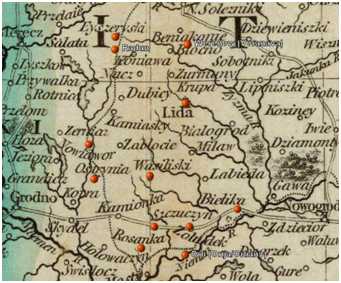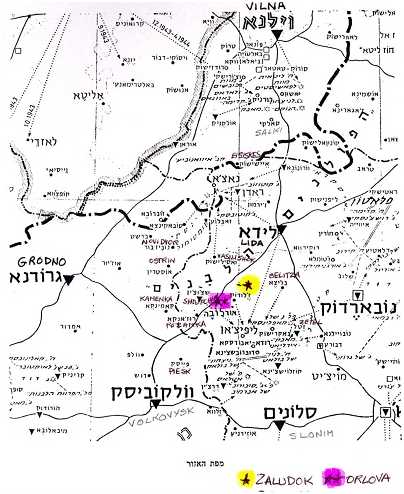 |
|
| Contents | |
| Lida Uezd Homepage | |
| Lida Uezd History | |
| Lida Uezd Towns | |
| Lida
Uezd Maps |
|
| Searchable
Databases |
|
| Lida
Uezd
during the Holocaust |
|
| JewishGen
Home Page |
|
| KehilaLinks
Home Page |
|
|
 VORANAVA VORANAVA Alternate
names: Voranava and Воранава [Bel],
Voronovo and Вороново
[Rus], Woronów [Pol], Voronova and וואָראָנאָבע
[Yid],
Varanavas [Lith], Voranova, Voronov, Voronove, Werenów,
Woronowo, Woranawa, Bolotna, Werono. 54°09'
N, 25°20' E, 37 miles S of Vilnius (Vilna),
18 miles N of Lida. Jewish
population was 1,432 in 1897. 1993 town population: 6,800. This village
is one km from the railway station on the railway line: Lida-Vilnius,
on the road: Lida - Vilnius. and
the dependent villages, hamlets, and estates of Soletchnik
(Great and Small)/ Turgel/Trokele/Trokiele
at 54°02' 25°25'; Meretz,
Lebedi/Lopaty/Lebishok
at 53°33' 245°1'?, Oran, and Rashin, Rudan Dekanat First
found in the Chronicles of the sixteenth century as a part of Great
Lithuanian Principality, Voranava’s ancient name was Bolotna (Blotna), deriving from its
location on the river Balatnyanka, now a small stream. Polish sources
call it Werono. Russian sources
call it Voronov. On the map of T.
Makovski In
1690, Voranava had sixty-one houses, a Catholic Church, and a tavern.
At the beginning of the eighteenth century, A. Masevich owned Voranava.
In 1705, he began building the Catholic Church of St. Tadeush. Later,
the town belonged to Stipion and then to Zaretski. In 1735, Yakov
Stipion opened a secondary school. At this time, Voranava was the
center of starostat (district.) In 1795, Voronovo belonged to the
Russian Empire as a mestechko of Lida powet (district). In 1865, the
population was 468 people (18 Orthodox, 117 Catholics, and 333 Jews.)
Voronovo had forty-two houses, a Catholic church, a synagogue, a prayer
house, a water mill, twelve shops, a post office, a post station,
weekly fairs, and two leather factories. Close to Voronovo was an
estate (or a colony with the center called Rudan
Dekanat) with one hundred Catholics, eighteen Orthodox and
eight Jews. In this colony was a wine factory, the wooden church of St.
Zbivatselya. The 1897 population was 1574 people: 1,432 of them Jews. In
1921, Voranava belonged to Poland as the center of gmina of Lida povet,
Novogrudok voevodstvo. In 1928, Voranava was designated as a miasteczko
(small town) (?in the gmina of Bieniakonie?), in the First Uchastok of
Lida powiat, Nowogrodskie voevodstvo of Poland. The Justice of the
Peace was in Eisiskes and the Justice Court in Wilno. The 1928
miasteczko population was 1,232. The railway station was a train stop
for limited transports in Woronow II on the Lida-Wilno line. The post
office and telephone were in Woronow and telegraph in Lida. Voranava
had one Catholic church, one synagogue, mills, and a Merchants
Association. Markets were on Tuesdays. In 1939, Voranava belonged to Belorussian Soviet Socialist Republic. On January 15, 1940, Voranava became the regional center. On June 23,1941, the occupying Germans killed more than 2600 people from Voranava and those who had been brought to Voranava from Vilna. Liberation from the Germans by the Red Army was July 11, 1944. LOCATION
AFTER 1939: Baranavichy
Oblast (Belarusian: Баранавіцкая вобласць, Russian:
Барановичская Область) was a territorial unit in the Belarusian Soviet
Socialist Republic created after the annexation of West Belarus into
the BSSR in November 1939. The administrative centre of the province
was the city of Baranavichy. The voblast was originally known as the Navahrudak
Voblast but it was soon renamed to Baranavichy Voblast. The
oblast was made up of 26 raions in 1944. These raions were
Byten, Gorodyshche, Ivyanets, Iwye, Yuratishki, Karelichy, Kletsk,
Kozlovshchina, Lyakhavichy, Lida, Lubcha, Mir, Masty, Navahrudak, Nova
Mysh, Nesvizh, Radun, Slonim, Stowbtsy, Shchuchyn, Vasilishki,
Valozhyn, Voranava, Dzyatlava, Zel’va and Zheludok.
In 1944, the oblast was diminished after transferring raions
of Lida, Radun, Schuchyn, Vasilishki, Voranava, Masty, Zel’va
and Zheludok to newly founded Hrodna Voblastones
of Iwye, Yuratishki and Valozhyn to Molodechno Voblast in
1944. Finally on January 8, 1954 the oblast was liquidated and the
raions were divided between the Brest (Raions of Gorodyshche,
Lyakhavichy and Novo Mysh), Grodno (Byten, Karelichi, Kozlovshchina,
Lubcha, Mir, Navahrudak and Slonim), Molodechno (liquidated in 1960)
(Raion of Ivyanets) and Minsk (Raions of Kletsk, Nesvizh and Stowbtsy)
Olbasts (Modern Brest Voblast, Hrodna Voblast and Minsk Voblast). Thus,
Baranavichy became part of Brest one as raion center after Nova Mysh
one's center was moved to Baranavichy in 1 May 1954 and renaming it as
Baranavichy one after 8 April 1957 (Founded
after
remaining parts of Belastok Region to Belarus in 1945) and .
Today:
Radun is in Voranava District, Hrodna Voblast, Belarus. The
1970 population was 3,600 people. 1992: milk factory, bakery, and wine
factory. Civic facilities: professional training school, secondary
school, musical school, sports school, two kindergartens, school
student center, House of Culture, two libraries, hospital, cinema,
Monument to the Victims of Fascism (Nazis). Yaffa
Eliach, There Once was a World,
(Little Brown, 1998) has a picture of cows coming home to the village
of “Warinova” on page 267. She also says that the
town soccer team called Vulcan had some of the better Eisiskes players.
On page 530 is a photo taken May 26, 1924and dedicated to the Eisiskes
player, Velvke Saltz. HAMELITZ DONORS:
In 1885 the following donated money for the
relief of fire victims in Grodno: Tomtov Divanitzki, Hillel Peisachov,
Michal Zilberman, Khanukh Zilberman. FAMOUS SONS:
HOLOCAUST:
CEMETERY
SOURCES
If
you have Lida uezd
materials to share, please considering donating it.
If you read Yiddish or Hebrew, please contact us.
Records are
held both in Grodno and Vilna archives.For Lida records translation,
your tax deductible contribution by credit card via the secure server
at either group or by mail will grow our knowledge. For a $100
donation, you receive all these records translated two years ahead of
their posting on JewishGen. Every penny collected is used for Lida uezd
projects only. Records include censuses; family lists; marriages,
births, death records; prenumeraten lists; and more. Please contact Judy Baston
with any questions.For current translations, please see the ALD:
All Lithuanian Database and Belarus
SIG Database.
|

